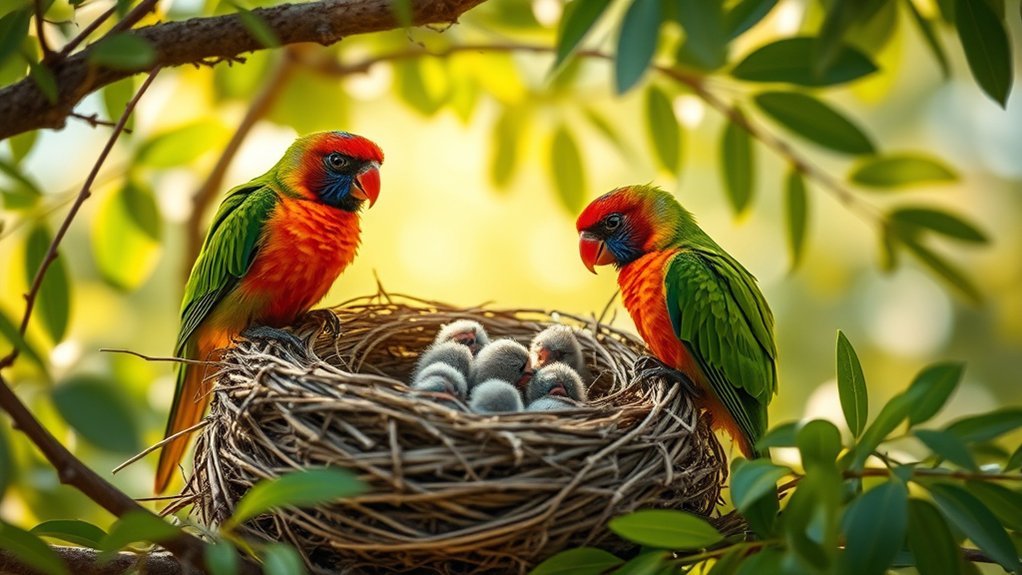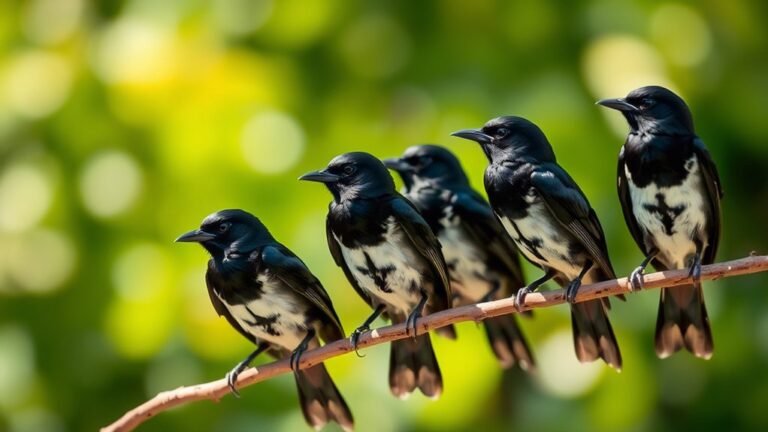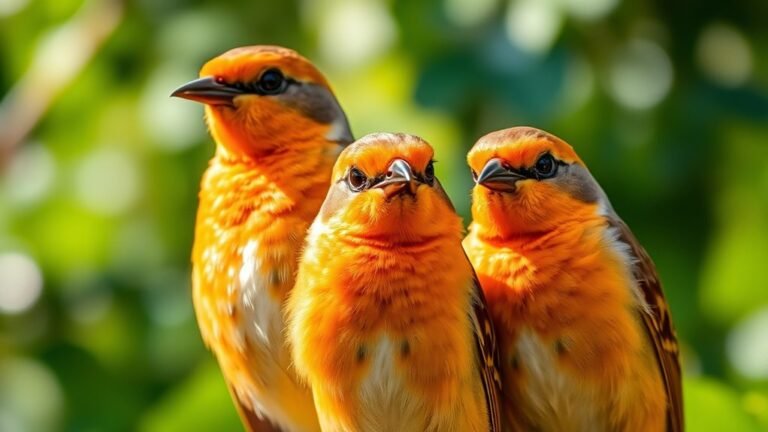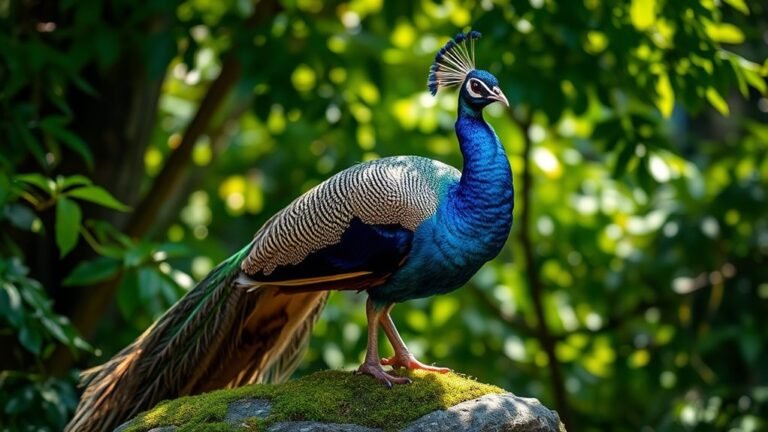Understanding Bird Reproduction: The Basics
Birds reproduce through a series of important steps, starting with their mating rituals. These rituals help birds find mates and build strong relationships. Different bird species have their own ways of mating. Some birds stick with one partner, while others have multiple mates. They also show off through courtship displays to attract each other.
After mating, the next big steps are nest building and laying eggs. Birds work together to create a safe and cozy place for their eggs. They use materials like twigs, leaves, and feathers to make the nest just right. Once the nest is ready, the female lays her eggs. The number of eggs can vary depending on the species.
These steps are crucial. A well-built nest and the right number of eggs can help ensure that the baby birds will grow up healthy.
A Quick Overview
- Male birds attract female birds with their dances and songs. This helps them find mates and show their territory.
- When it's time to build nests, birds choose safe spots and gather materials to make strong homes for their eggs and baby birds.
- Birds usually lay eggs in spring or early summer. This timing depends on how warm it is, how much food is around, and if the environment is stable.
- When baby birds leave the nest, it's called fledging. They need help from their parents to learn how to find food and stay safe.
- To help birds reproduce, people work on keeping their habitats safe. Community participation is important to support bird populations facing problems.
The Mating Rituals of Birds

Have you ever thought about how birds find their mates? Bird mating rituals are interesting and fun to learn about! Male birds show off to impress female birds. They often do special dances to show how strong and fast they are. Each bird species has their own unique dance moves.
Songs are also important in bird mating. Male birds sing specific tunes. These songs help them claim their territory and attract females. Female birds listen carefully. They choose mates based on how well the males sing.
Studying these rituals helps us see how different birds are. It also shows us the natural behaviors that help them reproduce and survive. Watching bird courtship can be both educational and enjoyable!
Types of Bird Mating Systems
Birds have different ways of mating, and knowing about these can help us understand how they raise their young. Here are the main types of bird mating systems:
- Monogamous relationships: One male and one female stick together for a breeding season or longer. They both help raise their chicks.
- Polygamous structures: One male mates with many females. This helps mix genes and can make stronger babies.
- Polyandry: One female mates with several males. This can be good for the eggs in some places.
- Promiscuity: Both males and females have many partners. They don't form strong bonds, which can help keep the gene pool healthy.
- Serial monogamy: Some birds have one mate for one season and then find a new one in the next season.
Learning about these systems shows us how birds adapt to survive and thrive in their environments.
The Role of Courtship Displays

Birds have special ways to impress each other when it's time to mate. These ways are called courtship displays. They include pretty songs and fun dances. Male birds often sing and show off their best moves to prove they're strong and healthy.
When a bird sings or dances, it grabs the attention of potential mates. It also helps set up a pecking order among other males. So, when you watch birds, you can see how they interact and what makes them special.
These displays are important for birds because they help them find partners and succeed in having babies. Understanding these behaviors makes you appreciate birds even more. You see how they connect with each other in nature.
Courtship displays remind us that every creature has its own way of communicating and building relationships.
Nest Building: A Critical Step
Nest building is a key task for many birds after they mate. They collect and arrange materials to make a safe home for their future babies. You can see many types of nests, each one fitting the bird's needs and the place it lives.
Here are some important parts of nest building:
- Nest materials: Birds use twigs, grass, leaves, feathers, and mud.
- Location: They pick safe spots to keep away predators.
- Structure: Nests need strong bases to handle the weather.
- Insulation: Birds layer materials to keep the nest warm.
- Size and depth: They make sure the nest feels cozy for eggs and chicks.
When you know about nest building, you can better appreciate birds and the hard work they put in to raise their young.
It's fascinating to see how each bird species has its own way of making a home!
Egg Laying: Timing and Conditions

Birds lay their eggs at certain times to help their babies survive. They pick the best time based on things like the temperature, how much food is around, and the length of the day. Most birds lay their eggs in spring or early summer when there's plenty of food to help raise their chicks.
Weather also matters. If the weather is nice and steady, birds feel safer laying their eggs. They also pay attention to predators that might harm their eggs.
The Anatomy of Bird Eggs
Bird eggs are amazing natural structures. They're built to protect and help baby birds grow. Let's look at the parts of an egg and why they matter.
- Shell: This hard outer layer protects the egg. Its thickness can change depending on the bird species.
- Membranes: There are two membranes inside the shell. They keep out bacteria and help keep the egg safe.
- Albumen: This is the egg white. It provides water and protein, which are important for the baby bird's growth.
- Yolk: This is the yellow part. It's full of nutrients and gives the baby bird energy to develop.
- Egg Color: The color of the egg can help it blend in with its surroundings. It also can show how healthy the bird is, and colors can differ between species.
All these parts work together to keep the baby bird safe as it grows inside the egg.
Bird eggs show how birds have adapted to their environments. They aren't just eggs; they're a big part of creating new life.
Incubation Periods and Methods
When birds lay eggs, an important time starts called the incubation period. This period is when the baby birds grow inside the eggs. It usually lasts between 10 to 80 days, depending on the type of bird. To help the eggs hatch, it's crucial to use good methods during this time.
Different birds have different ways to keep their eggs warm. Chickens use their own body heat to keep their eggs at the right temperature. Other birds, like the Wilson's plover, work together and take turns keeping the eggs warm.
The best temperature for the eggs is around 37.5 degrees Celsius (99.5 degrees Fahrenheit). Humidity, or the amount of moisture in the air, is also important. It helps keep the eggshell strong and supports the baby birds as they grow.
Parental Care in Birds
Parental care in birds is very important for keeping their young safe and helping them grow. Birds use different ways to care for their chicks and make sure they can survive. Many birds form pairs to work together in raising their young. Some species even get help from other birds, which is called cooperative breeding.
Here are some key things birds do to take care of their chicks:
- They build nests to keep their babies safe.
- They feed their chicks healthy food so they can grow strong.
- They keep the nest clean to stop germs and sickness.
- They watch out for dangers and protect their young from predators.
- They teach their chicks how to find food and stay safe when they're older.
These caring actions show how much effort birds put into raising their babies. This caring behavior is important for their success in having healthy, happy chicks.
The Impact of Environmental Factors
Many things in nature affect how birds raise their babies. Changes in the weather can change when birds decide to have their babies and make it hard for them to find food or good places to build nests.
When places for birds to live are taken away, it becomes tougher for them to find food to feed their chicks. If the seasons change too much, birds may lay their eggs at the wrong time, which can hurt the growth of their babies.
Also, pollution can make conditions harmful, affecting how well birds can make babies and how many chicks survive. Knowing how these issues connect is important for anyone who cares about helping bird populations and their homes.
It shows why protecting nature is so crucial.
Fledging: When Young Birds Leave the Nest
Fledging is an important time in a young bird's life. It's the step from being a nestling to becoming independent. During this time, many things affect how these young birds grow up.
First, fledglings deal with more competition for space in the nest. They often have to share with siblings or other birds nearby. This can make it harder for them to get enough room.
Second, many fledglings face danger after leaving the nest. They've to learn how to find their way around, and not all of them survive this tough time. Their chances go down when they first try to fly and find food on their own.
Third, as fledglings grow, their parents start feeding them less. This encourages the young birds to look for food themselves. They learn to forage and become more self-sufficient.
Fourth, successful fledging depends on practice. Young birds need to train their flight skills. They must try many times to get better at flying so they can find food and avoid dangers.
Lastly, weather can play a big role in the survival of fledglings. If the environment is harsh, it can increase the chances of them not making it.
Learning about fledging helps us understand how delicate young birds' journeys to independence can be. It's fascinating to see how they grow and change during this time!
Survival Strategies for Young Birds
When young birds leave their nests, they face many challenges to survive. One of their biggest worries is avoiding predators like hawks and cats. They use their natural instincts and blend into their surroundings to stay safe. They also stick close to trees and bushes, and fly quietly to keep away from danger.
Finding food is another important task for fledglings. As they explore, they compete with older birds for food. Learning to spot different types of food helps them a lot. It's also helpful for them to hang out with other young birds. They can learn from each other and get better at finding food and staying safe.
Challenges in Bird Reproduction
Birds face many challenges when it comes to having babies. These challenges can make it hard for their species to survive. Understanding these issues helps us appreciate birds and their lives better. Here are some of the main challenges:
- Reproductive barriers: Sometimes, different bird species can't mate. This can happen because they've different mating calls or they don't have the same breeding times.
- Habitat destruction: Birds need safe places to nest and enough food to feed their young. When humans destroy their habitats, it can make raising chicks difficult.
- Climate change: Changes in the weather can confuse birds. It might affect when they breed or if there are enough places for them to live.
- Predation: When there are more predators, like cats or raccoons, many chick birds may not survive. This can lower the number of young birds a species has.
- Genetic diversity: If birds in a group are too related, they might've health problems. This can make it hard for their babies to be strong and healthy.
Conservation Efforts for Bird Populations
Birds face many dangers today, like loss of their homes and climate change. That's why conservation efforts are important. These efforts help protect birds for the future.
You can help by supporting projects that save habitats. These projects work to restore and protect the places birds need to live. Breeding programs also play a big role. They focus on helping endangered bird species reproduce to keep them alive.
Joining campaigns that raise awareness about bird challenges helps spread the word. It brings people together who care about protecting wildlife. When you take part in these efforts, you join a community that cares about birds and nature.
All these actions help birds stay safe and thrive. They also show our commitment to taking care of the Earth for future generations. Everyone can play a part in saving our feathered friends!
Frequently Asked Questions
How Do Environmental Changes Affect Bird Reproductive Success?
Environmental changes can affect how well birds reproduce. When habitats are destroyed, there are fewer places for birds to build nests and raise their young. This means birds might have trouble finding enough food, leading to fewer baby birds being born. As a result, some bird species might not survive as their numbers drop.
Birds also face changes in the climate. If temperatures change or if seasons shift, birds may have to adapt quickly. This can make it harder for them to find food or time their breeding correctly. If they can't adapt fast enough, their ability to reproduce might suffer.
What Is the Average Lifespan of Birds in Different Mating Systems?
Birds live for different amounts of time depending on how they mate. Some things that affect how long birds live include where they live, if there are predators around, and how much energy they spend on babies.
Birds that are monogamous, which means they mate with one partner, often live longer than birds that are promiscuous, or that mate with many partners. This difference in lifespan helps us understand how their ways of mating can affect their health and life.
Can Birds Mate With Other Species, and What Happens?
Birds can mate with other bird species, and this can lead to hybrids. Sometimes, the young birds that are born from these mixes can be strong and healthy. But usually, different bird species keep to themselves and do not mate.
Birds choose their partners based on behaviors and songs. These differences affect whether two types of birds will even try to mate. If they do mate, the babies might face challenges. They may not be as healthy or might even find it hard to have babies of their own.
How Do Social Structures Influence Bird Reproduction?
Social structures play an important role in how birds reproduce. They help birds form strong partners, choose the best mates, and even build nests together. These activities make it easier for birds to raise their young successfully. When birds work together, they also build friendships and social bonds within their groups.
In simpler terms, when birds live in groups, they can help each other out. This teamwork not only helps them find the right mate but also makes sure their babies have a better chance of growing up healthy. So, social structures are really helpful for birds when it comes to having and raising their young.
What Genetic Factors Impact Bird Fertility and Reproduction?
Genetic factors play a big role in bird fertility. Birds with more genetic diversity usually have better success in reproducing. Certain genes control important traits that help them mate. These genes work together to affect how well birds can reproduce in their surroundings.
In simple terms, if a bird has a variety of genes, it is more likely to have babies. Some special genes help birds find partners and successfully lay eggs. All these factors help birds thrive and keep their population strong.

Luna is the passionate founder and author of Birds and You, a website dedicated to sharing her love for birds with fellow enthusiasts. Through her engaging articles and guides, she aims to educate and inspire others to explore the fascinating world of birds. When she’s not writing, you can find Luna observing birds in their natural habitats or sharing beautiful bird photography on Pinterest. Join her on this journey to celebrate and protect our feathered friends!







